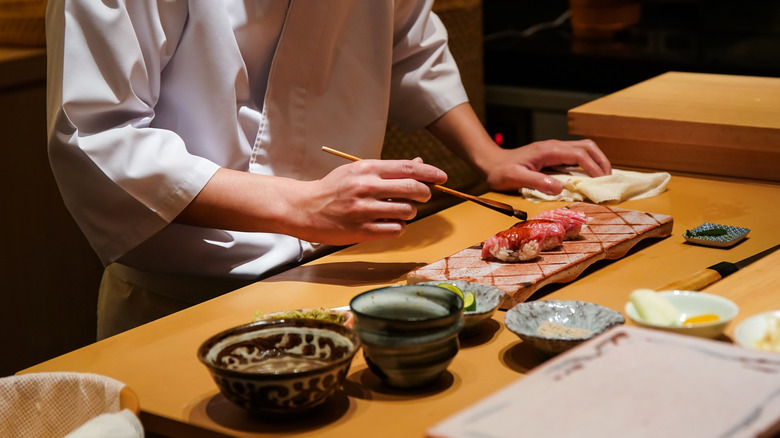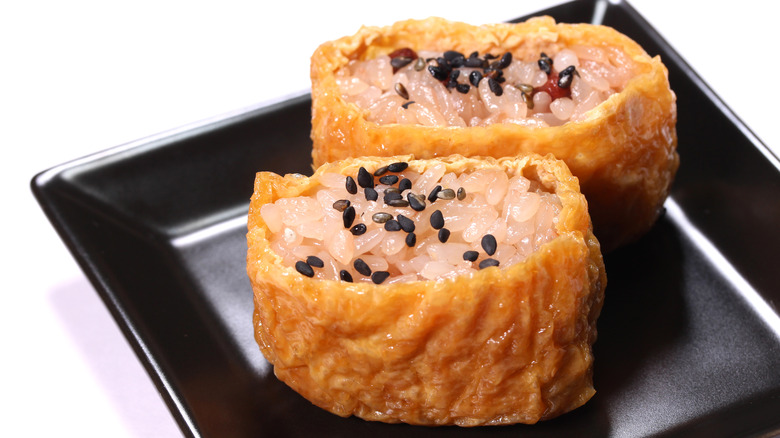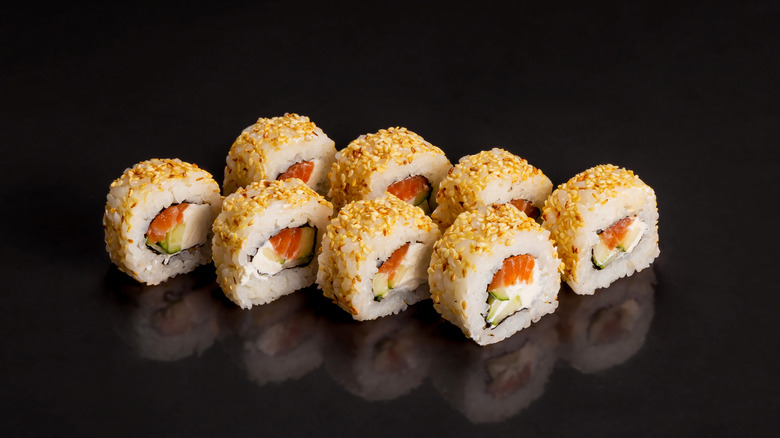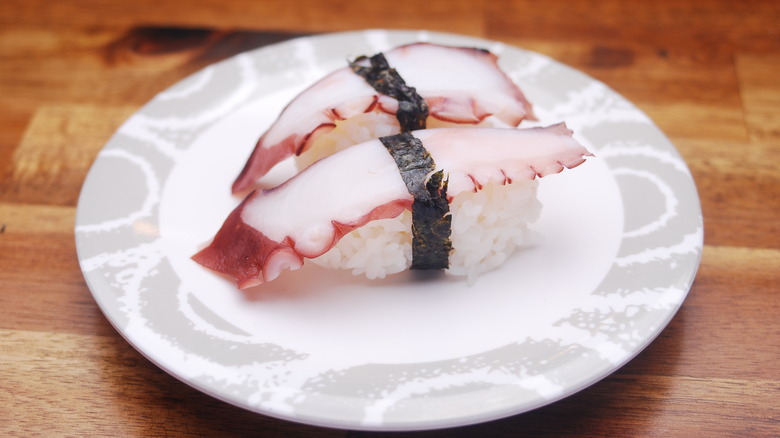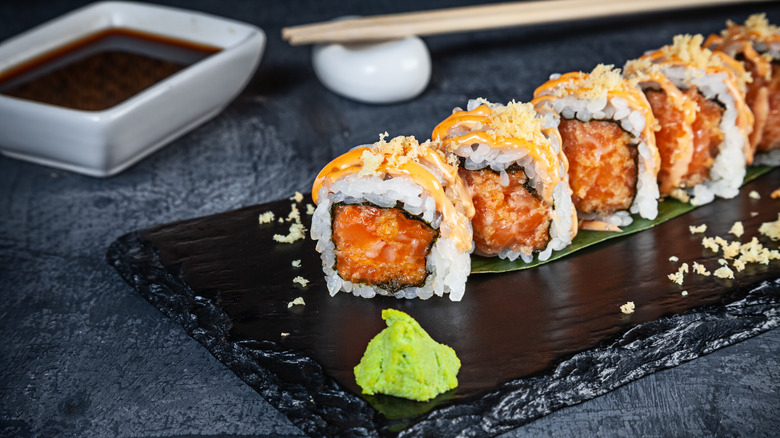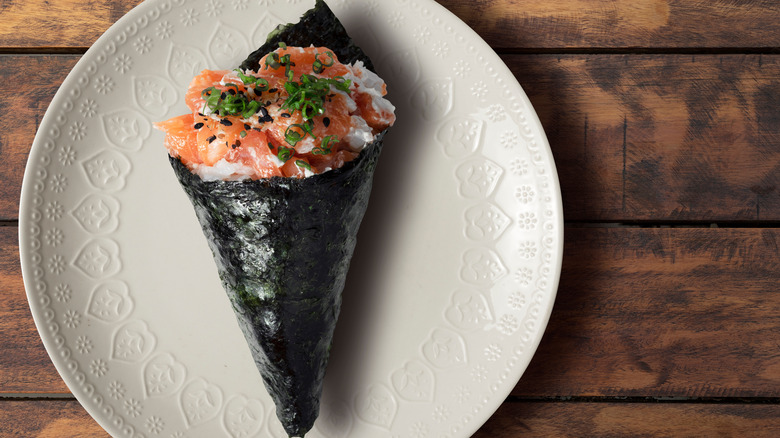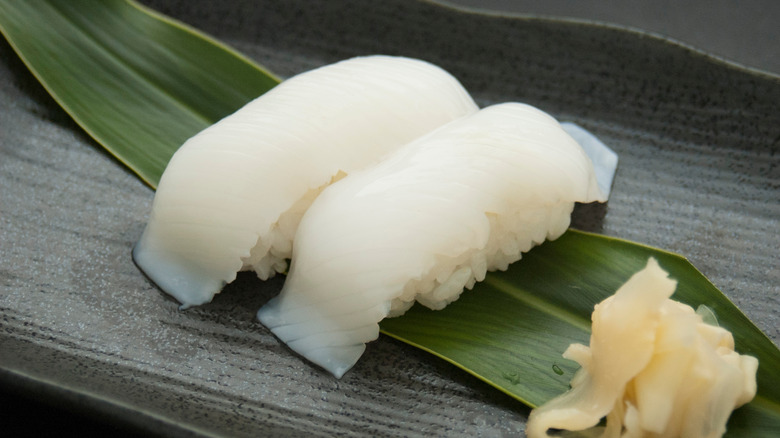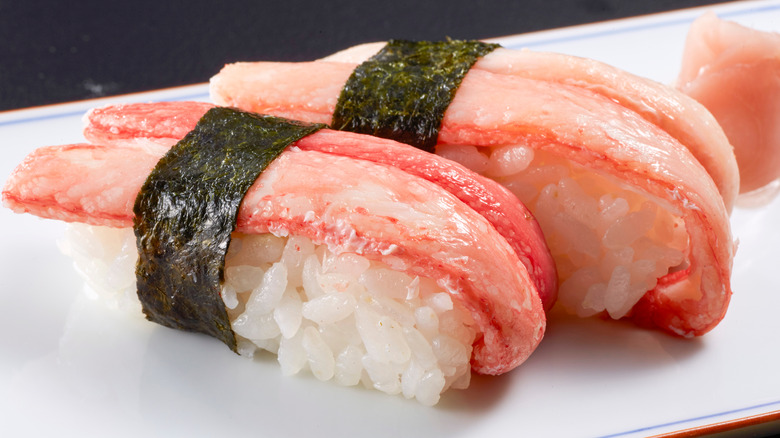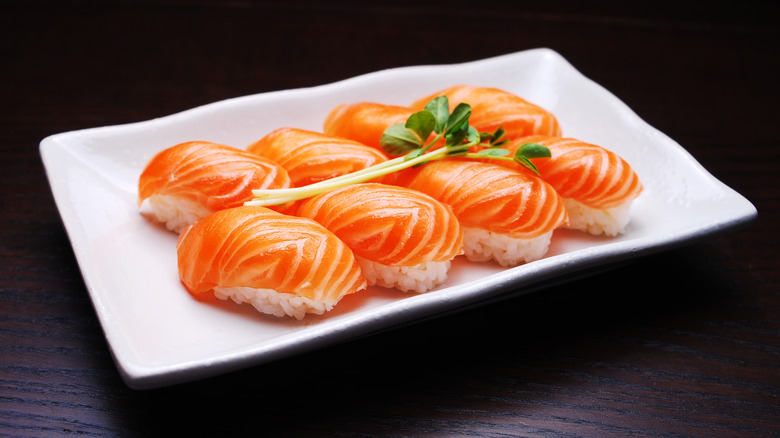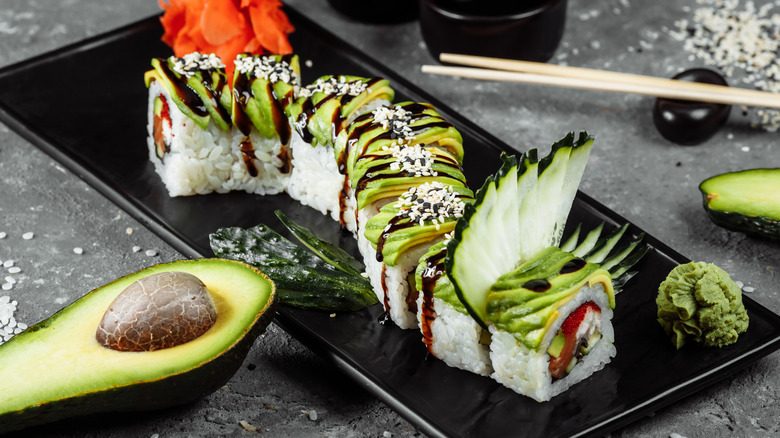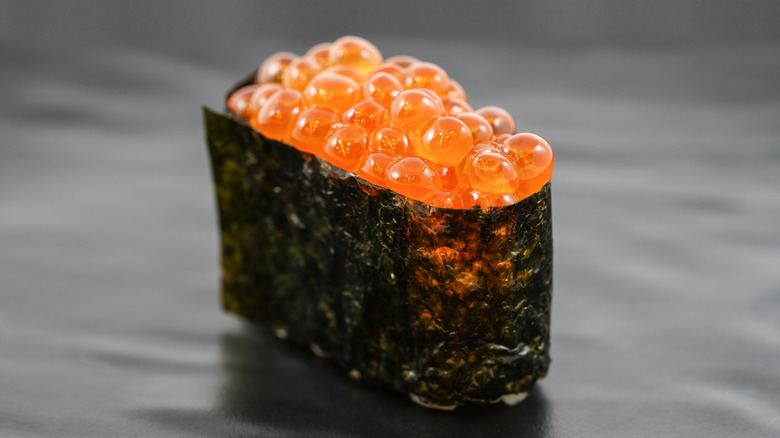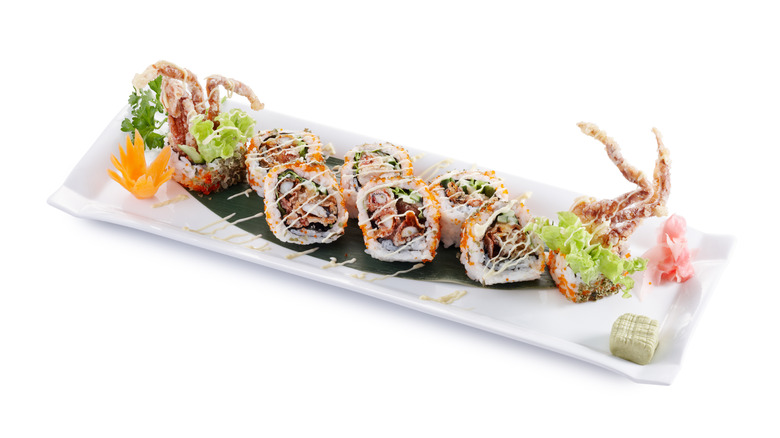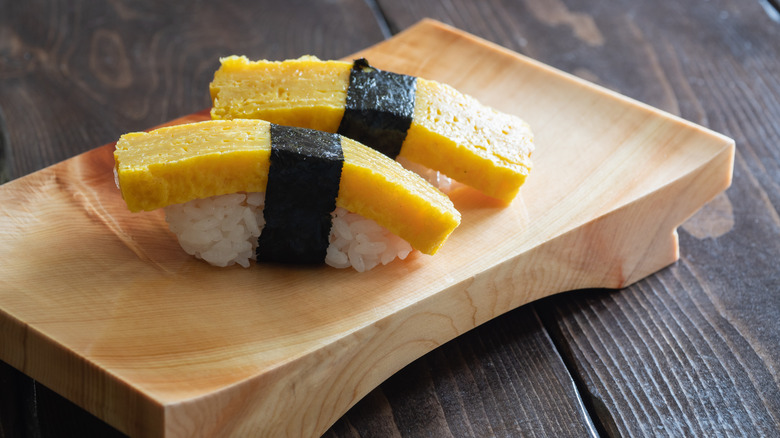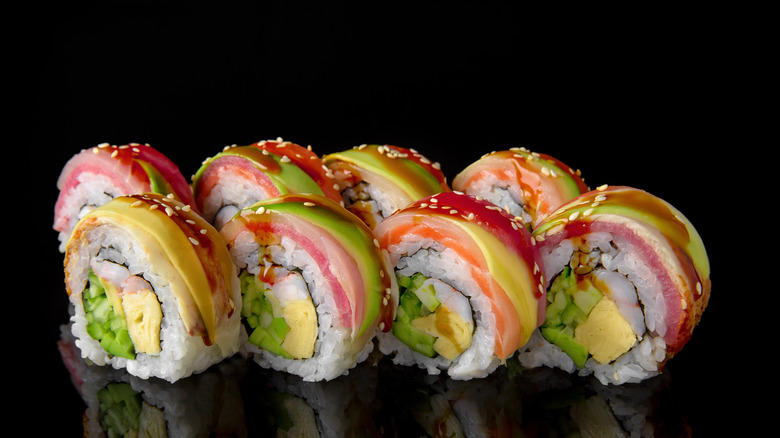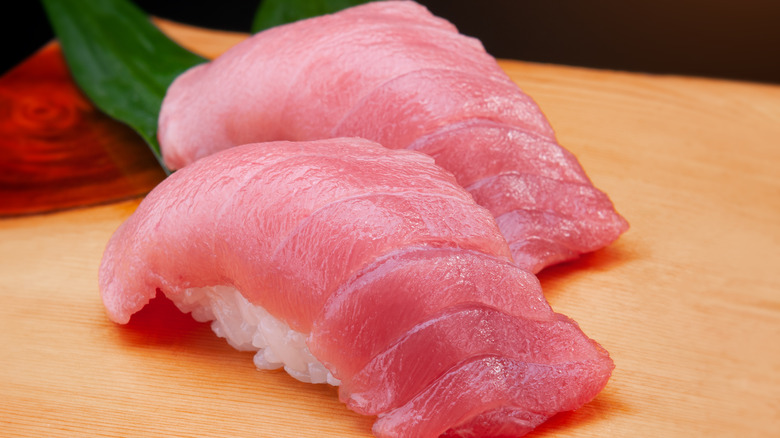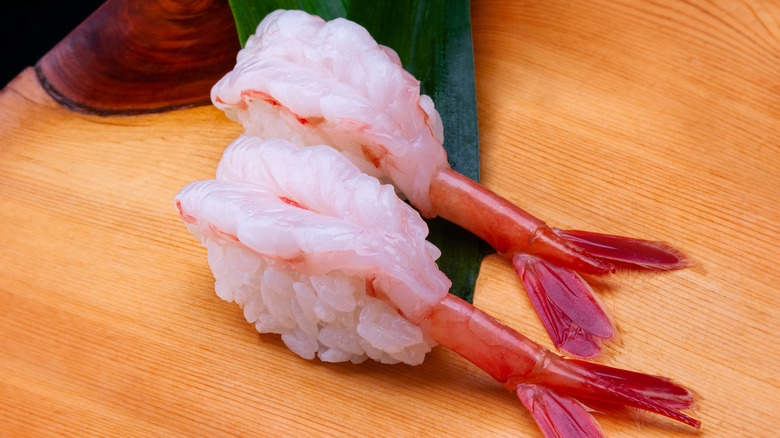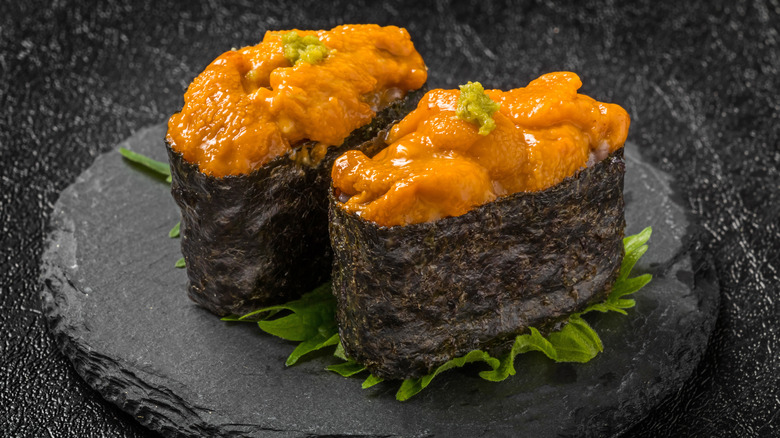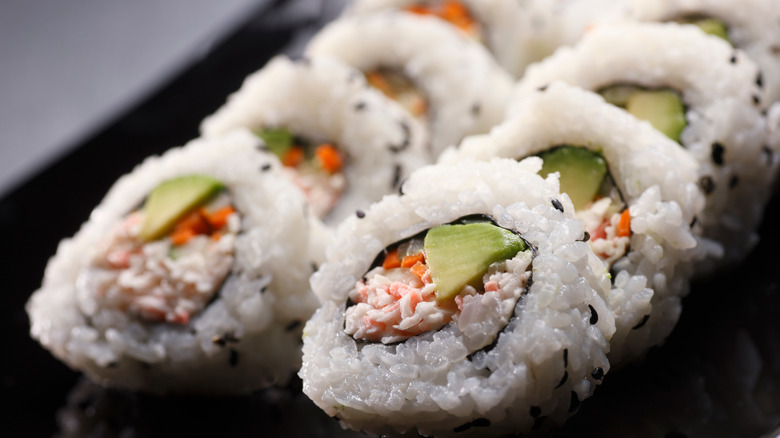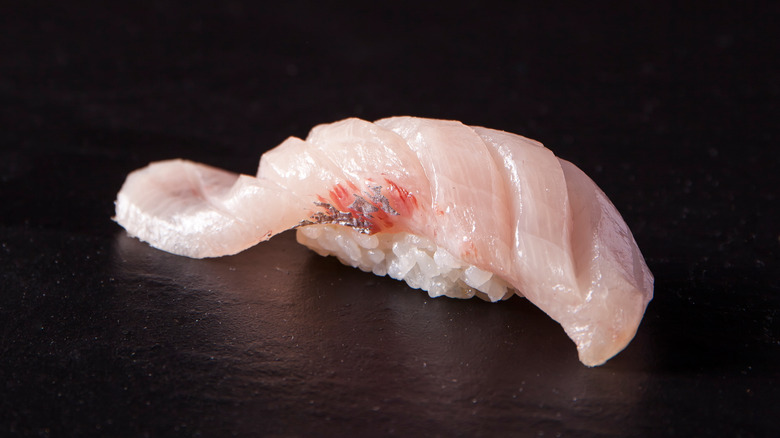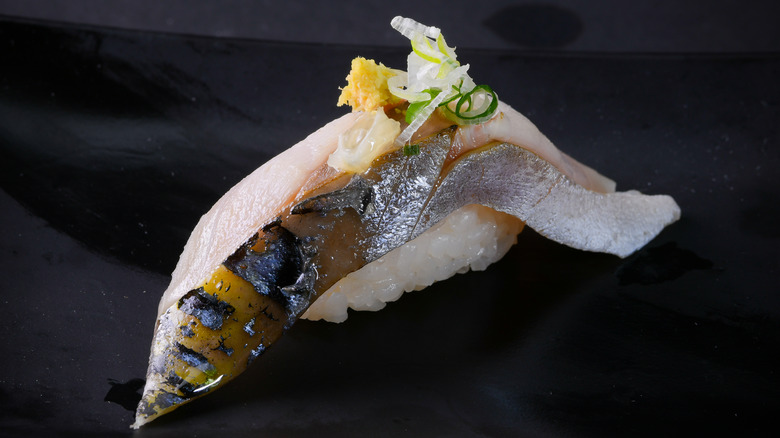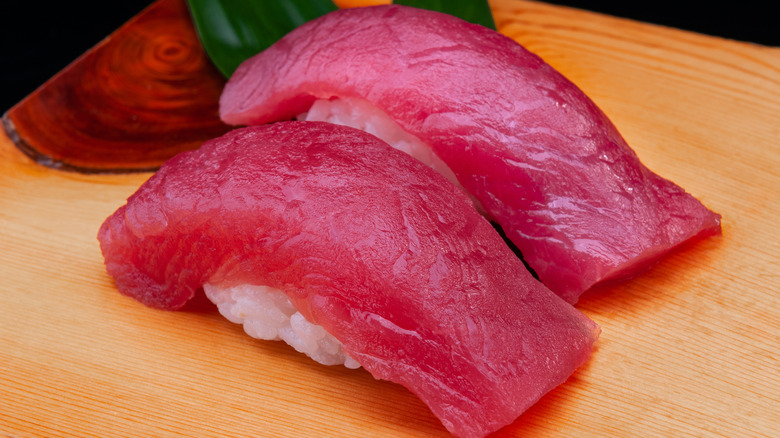The 20 Best Types Of Sushi Ranked
Perhaps the most iconic Japanese food, sushi goes far beyond its initial impression of raw fish and rice. At its highest level, sushi is complex, with intricate knife work and deceptively simple components, such as sumeshi (the seasoned rice), often hailed as the most important part of great sushi (via Serious Eats).
Of course sushi has also gone international, appearing everywhere from the U.S. to Italy, and with this global change comes different ingredients and palates. What might be surprising to many American sushi fans is that some of their favorite rolls were created in the United States. In Japan, sushi generally features far less ingredients, skipping the tempura bits, spicy mayo, and sweet sauces that covers many international sushi creations.
Sushi consists of three types: nigiri, maki, and shashimi (via Masterclass). Nigiri is made from a small oblong wad of sushi rice covered with a piece of fish or shellfish; Maki is rolled sushi, with its ingredients encased by sushi rice and wrapped in nori seaweed; and sashimi is just the raw fish slices — no rice included.
But as there's an endless variety of sushi within these three styles, selecting the best ones for you can be a tricky endeavor. For this list, Tasting Table has curated a variety of popular and underrated Japanese and American sushi styles. While the Japanese style focuses on fish quality and elegant techniques, sometimes a sauce covered, deep-fried roll just hits the spot.
20. Inarizushi
Sushi is more than just seafood, and a great example of this is inarizushi. Translated as "fox sushi" by NHK World, the sweet, stuffed abura-age, or fried tofu, is named after the Japanese folk belief that foxes love the ingredient.
Filled with seasoned sushi rice, Serious Eats shares inarizushi can also contain ingredients like shiitake mushroom, umeboshi (which are pickled Japanese plums), or sesame seeds. The flavors of this often vegetarian sushi are hearty, with plenty of texture and sweetness from the abura-age, which is marinated in soy sauce, sake, and mirin, and sometimes dashi. In Japan, inarizushi are commonly enjoyed in a bento or as a picnic item.
19. Philadelphia Roll
It should come as no surprise that aptly named Philadelphia roll was first created in the city of Philadelphia. Inspired by Jewish cuisine, Madame Saito (aka the "Queen of Sushi") is often credited as the inventor. Saito told The Philadelphia Inquirer that she created the Philadelphia roll after eating breakfast at a friend's house in the 1980s. Taking inspiration from the meal and her customer's suggestions, she dubbed the sushi roll — made by combining salmon and the Philadelphia cream cheese — the Philadelphia roll.
Like other Americanized sushi rolls, the Philadelphia roll was created as way to ease Americans into eating raw fish. While the idea of cream cheese in sushi may seem strange, there's a logic to this flavor combination. After all, as Saito discovered during that fateful brunch, cream cheese and smoked salmon is a popular bagel combination, so why not roll it into sushi rice?
18. Tako
Unlike most other sushi ingredients, tako, or octopus, needs several hours of preparation before it can be served. This is because fresh raw octopus is far too tough to be eaten straight (via Sushi University). Improperly prepared octopus is rubbery and basically inedible, making this seafood item a difficult ingredient to master.
To prepare octopus, sushi chefs will either tenderize it deeply by hand or simmer it in water or a mixture of soy sauce, sake, and mirin (called sakura-ni), giving it an extra boost of flavor. After this process, the octopus is sliced thinly and placed on top of sushi rice for nigiri. Well-prepared octopus sushi should be tender with a pleasant firmness, accented by a fragrant meaty flavor.
17. Spicy Tuna
A heady mixture of raw tuna and hot sauce, the spicy tuna roll is easily one of the most popular menu items in American sushi restaurants. Thrillist credits the creation of the spicy tuna roll to Maneki restaurant in Seattle. They explain that, back in the 1980s, spicy dishes weren't that common in Japanese cuisine. The chef was inspired by their love of chili sauce, and combined the ingredient with the fish pieces leftover after cutting tuna for other dishes.
One fact that might be surprising to fans of the spicy tuna roll is the preparation of the tuna itself. Most spicy tuna rolls are made from something called "tuna scrape," which is essentially tuna flesh that's been scraped from the skeleton after most of meat has been removed (via PBS). But don't let that scare you off — if you're a spice fan you won't be sorry you ordered this popular roll, as the flavor pairs well with the meaty, fatty tuna.
16. Temaki
Besides nigiri and maki rolls, another common type of sushi is the temaki. Translating to "hand roll," according to Serious Eats, temaki is basically sushi rice and ingredients wrapped in a nori cone. Considered by many to be the easiest sushi to make, temaki can feature a wide range of ingredients — from vegetables to cooked or raw fish to pickles. Because its filled with so many ingredients, it is generally recommended that the diner only dip the corner of the nori into soy sauce to avoid overpowering the flavors of the roll. Temaki ofent
While the temaki is easy to make, it plays a role in many omakase meals. Sushi chef Jay Zheng of Kōyō in Queens, New York, explained to The Manual that he prefers to serve temaki for a filling end to the multicourse meal.
15. Squid
With over 100 types of squid in Japan, squid is considered an affordable and common ingredient in Japanese cooking (via Sushi University). When served fresh and sliced properly, raw squid is a tasty sushi ingredient. The texture of raw squid is unique — soft with a pleasant, meaty bounciness — and the flavor is mild and slightly sweet.
While sushi made with squid can be served with the usual suspects (soy sauce and wasabi), this seafood greatly benefits from a squeeze of citrus. In Japan, many sushi chefs like to serve squid sushi with salt and sudachi, a small citrus similar to yuzu.
14. Crab
From the deep-fried soft shell crab in spider rolls to the Dungeness crab (or imitation crab, more often) in California rolls, crab is a popular sushi ingredient. In Japan crab is often served nigiri style, with the sweet shellfish being the star of the show.
Traditionally, crab wasn't used in Japanese sushi, explains Sushi University. However, modern Japanese sushi makes great use of the crustacean, ranging from snow crab to the impressive king crab. Generally, the crab legs, not the body, are used for sushi; and in the case of snow crab, specifically the male crab legs are prized, as they are sweeter and more tender.
13. Salmon
Probably the most common type of raw fish for sushi besides tuna, salmon is delicious both raw and lightly seared. While there are many varieties of salmon, masunosuke, or king Salmon, is considered to be a top choice for sushi (via Sushi University). King salmon has an excellent combination of fat and flavor, making it perfect for nigiri preparations.
Interestingly, salmon sushi wasn't always popular in Japan. Traditionally, salmon was consumed grilled or simmered in soups and stew. Raw salmon was considered inedible, filled with too many potential parasites to safely eat raw. This started to change in the 1980s when Norway began shipping its excess salmon to Japan. The Norwegian government partnered with Japanese frozen food company Nishi Rei to promote the ingredient, and soon the country began to accept salmon as an ingredient for sushi (via NPR).
12. Dragon Roll
This festive American-style sushi roll is generally filled with tempura shrimp, avocado, cucumber, and imitation crab, all topped with more avocado and a drizzle of unagi sauce (via Just One Cookbook).
The inclusion of unagi sauce on a sushi roll could surprising to Japanese diners, but this sweet and salty addition perfectly illustrates the general differences between American and Japanese sushi recipes. According to Yohei Matsuki, sushi chef of Michelin-starred Sushi Ginza Onodera in Los Angeles, American sushi diners generally look for a variety of flavors, sauces, and colors on their sushi (via Michelin Guide). In comparison, the Japanese sushi palate leans towards simple preparations that focus on the quality of the ingredients.
11. Ikura
Besides the actual fish, salmon roe, or ikura, is also a popular sushi ingredient. Ikura is highly prized in Japanese cuisine, possessing a distinctive flavor and texture. The best way to describe the roe is juicy, with a clean and briny taste that pops in the mouth. The name ikura is commonly thought to have originated from the Russian word for fish eggs, "ikra," although in Japan ikura refers specifically to those that come from salmon (via Sushi Modern).
According to Sushi Modern, before ikura can be eaten, it is washed several times in fresh water. Next, the ingredient is marinated in a mixture consisting of equal parts soy sauce and sake. For sushi, ikura is enjoyed scooped on top of sushi rice and wrapped in nori, like uni. The sushi is sometimes also topped with a quail egg yolk for increased flavor and mouthfeel.
10. Spider Roll
This fun-sounding roll is a classic of the American sushi lexicon. Filled with whole pieces of deep-fried soft-shell crab, avocado, cucumber, and sometimes asparagus or radish, this roll is hearty by sushi standards. The roll is named for the crab legs that are sometimes left sticking out of the sushi, creating a spider-like effect (via Delighted Cooking). This roll is generally accredited to Hidekazu Tojo, a Japanese sushi chef living in Canada and one of the potential inventors of the infamous California roll discussed above.
If you're wondering how one eats a whole, deep-fried crab, its important to remember that the crab used in this sushi roll are soft-shell crabs. Serious Eats explains crabs molt to replace their old shells, growing about 30% in size during this period. There's a very small window of opportunity to catch soft-shell crabs, as they remain so for only two to three hours before hardening again.
9. Tamagoyaki
Fish and shellfish aren't the only stars of the sushi show. Tamagoyaki, a Japanese omelet, is one such sushi ingredient that highlights the humble egg. In sushi, tamagoyaki can be served on top of rice as nigiri or by itself. Unlike American omelets, Japanese omelets have a sweeter flavor, the result of sugar and mirin that's added to the egg mixture before cooking, according to Just One Cookbook.
Besides the standard seasonings, some sushi chefs like to get creative. Marco Moreira of 15 East at Tocqueville in New York City told Thrillist they like to add ingredients like pureed shrimp and mountain yam to their egg. Because of its sweet flavor, many sushi chefs like Tomoyuki Hayashi of Michelin-starred Sushi AMANE, prefers to include tamagoyaki as the final piece of a sushi omakase meal, making this the "dessert" dish of sushi (via The Manual).
8. Rainbow Roll
Found on the menu at most sushi restaurants in the U.S., the colorful rainbow roll is essentially an upgraded California roll topped with slices of sashimi and other ingredients (like avocado, salmon, tuna, and yellowtail) explains The Japanese Bar. In addition to creating the eponymous "rainbow," these raw slices add an extra layer of flavor and texture to the well-balanced sushi roll. Though the filling may vary slightly depending on who is preparing it, in general you can expect a rainbow roll to have crab (real or imitation), avocado, and cucumber inside.
Like the California roll, the rainbow roll is an inside-out roll, meaning the rice is on the outside, and an American invention. Though the inventor of this roll is unknown, it is believed to have started appearing on menus sometime in the late 1960s or early 1970s.
7. Toro
Like all fish, different parts of the tuna will contain more fat than others. While lean akami is delicious, some sushi lovers prefer the luxurious and rich toro, cut from the fattier pieces of the tuna.
There are two main parts of the fatty tuna: chutoro and otoro, with the latter being the fattiest (via Sushi Modern). One bite of toro and you'll quickly realize that this is a completely different eating experience compared to lean tuna. Toro is prized for its melt-in-your mouth texture and will be instantly appealing to lovers of butter and fat. Some tuna sushi connoisseurs say toro tastes the same regardless of the quality of the tuna, in stark contrast to lean akami.
6. Shrimp
You may be familiar with shrimp tempura, which is used in many American-style sushi rolls, and while delicious, it is a completely different dish compared to shrimp nigiri. While American style sushi primarily features cooked shrimp, the seafood is often enjoyed raw in Japan. When served raw, shrimp retains more of its natural sweetness, increasing both umami and texture (via Sushi University).
There are many types of shrimp used in Japanese sushi — such as ama ebi, botan ebi, and shima ebi — each with their own flavor profiles and textures. Unlike the spicy mayo or unagi sauce that accompanies shrimp sushi in the U.S., raw shrimp sushi should be enjoyed with only a small amount of wasabi and soy to avoid overwhelming the natural flavors of the shellfish.
5. Uni
A prized ingredient in sushi, uni (or sea urchin) is a relatively modern addition. In fact, Sushi Modern explains it wasn't until after World War II that Japanese sushi chefs started to embrace the ingredient in sushi nationwide. These soft, orange, tongue-shaped pieces (the only part of uni that's edible — the gonads which produce roe, according to Food & Wine) possess a unique complexity. Flavor-wise, high-quality uni should be creamy and umami, with a natural sweetness and filled with briny ocean notes.
According to Sushi Modern, the most common way to serve uni in sushi is in a gunkan-maki, or a war ship roll, named for it's similar appearance to the large boat. The sushi rice for this roll is shaped into a long ball with the nori wrapped around it, making a cup shape. The uni is then placed on top of the rice, surrounded by the nori.
4. California Roll
One of the most popular sushi rolls in the U.S., the California roll was not invented in Japan. According to the Encyclopedia Britannica, the California roll was created in the 1960s by Japanese sushi chef Ichiro Mashita at Tokyo Kaikan, a restaurant in LA's Little Tokyo. However, there's some contention to this claim. Other sources claim the California roll was created in Canada by Hidekazu Tojo, head of Tojo's Restaurant in Vancouver (via South China Morning Post).
Everything about the California roll was precisely engineered for American taste buds. At the time, people living in the U.S. were wary of eating both raw fish and seaweed. To circumvent this, Encyclopedia Britannica states Mashita replaced the raw fish with cooked crab and avocado. The chef also used another technique for this creation — the "inside out" roll. This is essentially a sushi rolled with the nori inside the sushi rice, effectively hiding the seaweed from the consumer.
While California rolls can be made with Pacific Dungeness crab, imitation crab has become the default ingredient in most versions.
3. Kampachi
Kampachi, or greater amberjack, is a clean-tasting fish with a beautifully crisp texture and excellent balance of fat. Best consumed during summer and early fall, according to Savor Japan, kampachi is one of the best fish for nigiri. (As a bonus, kampachi is also a very sustainable seafood choice, according to the Monterrey Bay Aquarium Seafood Watch.)
For some sushi chefs like William Selin of Masu Sushi & Robata in Minneapolis, Minnesota, kampachi is a criminally underrated sushi fish in America. "It has a nice, firm texture, in addition to a little sweet and butter added to the acidity of the rice — you don't get much better than that," Selin said to Thrillist. Because of kampachi's natural fat, this fish is particularly delicious when paired with citrus like yuzu or Meyer lemon (via PBS).
2. Saba
Underrated in the U.S. for most sushi eaters, the humble mackerel, or saba, is a must-order for any sushi fan. For many, mackerel can be a divisive ingredient, seen as oily, fishy, and filled with bones. But when supremely fresh and prepared properly, mackerel can be delicious, with a rich and buttery flavor that's second to none.
As the fish with the longest history in sushi making, mackerel is generally pickled and cured in salt and vinegar before being made into sushi (via Food Republic). Contrary to urban myths, this pickling is not done to remove parasites, explains Sushi Modern. Rather, the process serves to add flavor to mackerel. Mackerel sushi is often served with grated scallions and ginger instead of the usual wasabi. The flavors of these aromatic ingredients are a perfect match for the fatty and naturally sweet taste of mackerel.
1. Akami
While individual taste may vary, there's no denying tuna's outsized influence in sushi. Besides its popularity, tuna is also literally huge. For instance, Pacific Bluefin Tuna can reach 10 feet in length and top 1,000 pounds in weight (via Monterey Bay Aquarium). Because it's so large, tuna is butchered into many cuts like beef, with some pieces being fattier than others. Perhaps surprisingly, expert sushi chefs will age tuna (and other types of fish) between two to 10 days to bring out the maximize amount of umami flavor (via Sushi Modern).
While the fatty parts of the tuna are highly prized, many sushi connoisseurs swear by the akami, or lean tuna meat. Because this part of the fish is pure lean meat, high-quality akami will contain the most natural umami compared to other tuna cuts, showcasing the quality of the individual fish. Much of the akami used for sushi is cut from the back of the fish because of its softer, superior texture when compared to the akami from the belly (via Sushi University).
